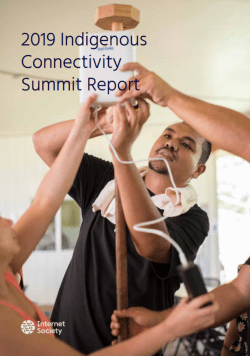Executive Summary
The 2019 Indigenous Connectivity Summit (ICS) was held in Hilo, Hawai’i on November 12 and 13, 2019 to build partnerships, advocate for regulatory changes, and share success stories of community networks throughout Canada and the United States. It drew nearly 100 participants in-person (and more than 43,000 virtual participants) for a two-day series of panels, presentations, and roundtable discussions on barriers to and solutions for Indigenous connectivity to fast, affordable, sustainable Internet.
While speakers and participants came from far and wide – from the Nez Perce Tribe in Idaho, to the Nation of Hawai’i, to the Canadian Arctic – core themes surfaced in discussions throughout the ICS. Participants emphasized the importance of using technology to preserve and pass on culture and language, strengthen communities, and create hope and connections for youth. Indigenous leaders shared stories of success, and highlighted the importance of partnerships with a wide variety of stakeholders.
The event culminated in the development of a set of policy recommendations:
- Native Hawaiians must be included as a Tribal Nation under the Federal Communications Commission’s (FCC) definition.
- Indigenous (Tribal, Native Hawaiian, First Nations, Alaska Native, Metis, and Inuit) governments and/or representative organizations must be engaged during the early planning stages of any project or policy that may affect their communities or land.
- All Indigenous communities are unique, so engagement must be made on a community-by- community basis.
- The FCC should push back the Tribal Priority window for the 2.5Ghtz Educational Broadband Service (EBS) Spectrum in the United States. The window should not begin until spring 2020 at the earliest and should be extended from a 90-day window to a 180-day window at minimum.
- Policymakers should work with appropriate representatives to improve and enforce accountability standards for companies or non-Indigenous entities working with Indigenous governments or other representative bodies.
- Organizations and agencies that use data on or intellectual property of Indigenous Peoples for their own purposes without consulting the owners of the knowledge should be held accountable.
- Policymakers should ensure that when new federal development funds for broadband are created, the criteria for applicants do not exclude Indigenous governments or community members.
- Federal regulators should ensure that Indigenous governments and Indigenous-owned entities have first rights to the spectrum over their lands.
Videos of the presentations and discussions are available at the Internet Society’s livestream channel at https://livestream.com/internetsociety/2019ics.
What is the Indigenous Connectivity Summit?
Indigenous communities across North America are pursuing creative, tenacious methods to connect themselves to the Internet. However, they continue to face unique challenges to connectivity, and are often left out of critical policymaking processes.
The Indigenous Connectivity Summit is an annual event to bring together Indigenous leaders, community members, community network operators, Internet service providers, researchers, and policy makers with a common goal: connecting Indigenous communities to fast, affordable, and sustainable Internet. The event provides a platform to elevate both successes and roadblocks, and to collaboratively identify action steps that stakeholders can take to ensure all Indigenous communities can connect themselves to the Internet.
The inaugural ICS was held in Santa Fe, New Mexico in November of 2017, and brought together a diverse group of participants to discuss the critical relationship between connectivity and community empowerment. The event highlighted a vital correlation between connectivity and various socio-economic benefits, and identified community networks as an ideal path for many Indigenous communities to drive their own connectivity solutions. The initial summit began a critical dialogue that has helped inform the Internet Society’s policy priorities, as well as the goals of each summit to follow.
The 2019 ICS was held in Hilo, Hawai’i on November 12 and 13, 2019. The conference took place at the University of Hawai’i at Hilo’s Hale‘ōlelo, the home of the Hawaiian Language College and the only Native language college in the United States. Discussions explored the current state of Indigenous connectivity, highlighted successful community networks, and identified opportunities for policy change. The summit also featured a series of flash sessions in which Indigenous community leaders shared how connectivity has impacted their communities and culture.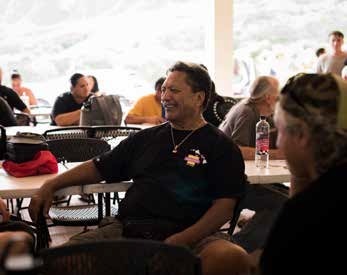
The Summit was followed by a three-day technical training and network deployment, in partnership between the Internet Society, MuralNet, and the Nation of Hawai’i. The result was a network, owned and operated by the Nation of Hawai’i, that now serves all of its 90 residents. Prior to the deployment of this network, Pu‘uhonua o Waimānalo residents had limited cellular access, or had to travel to town to connect at restaurants or other businesses.[1]
The 2019 ICS was presented by the Internet Society, in partnership with the First Mile Connectivity Consortium, the Internet Society’s Hawaii Chapter, the North American Network Operators’ Group, the Nation of Hawai’i, the University of Alberta, the University of Hawai’i at Hilo. The event was sponsored by Baicells, the Canadian Internet Registration Authority, Facebook, Hawaiian Telcom, Google, Comcast’s Internet Essentials, Iristel, and MuralNet.
The State of Connectivity in Indigenous Communities in North America
The Internet is a critical tool for Indigenous communities to leverage economic, healthcare, educational, and societal benefits. However, Indigenous communities remain some of the least connected in North America.
While complete and accurate data about the state of connectivity on Indigenous land is lacking, it is clear that communities are being left behind. In the United States, the federal government reports that 32 percent of individuals living on Tribal lands do not have access to fixed terrestrial Internet service speeds of at least 25/3 Mbps, the federal standard.[2] In Canada, the National Indigenous Economic Development Board found that when scored on a connectivity infrastructure index of 1.0, Métis communities scored 0.85, remote First Nations communities scored 0.59, and Inuit communities scored 0.11, while remote non- Indigenous communities scored 0.92.[3] Even in communities where broadband infrastructure is available, cost, speed, and reliability of service remain significant challenges.
Mobile broadband is more widely accessible than fixed terrestrial services, though similar challenges of cost, speed, reliability, and device limitations stymie what is possible. The 2019 Tribal Technology Assessment, conducted by Arizona State University’s American Indian Policy Institute, found that while a third of survey respondents indicated that they relied on a cell phone for home Internet, the choice was primarily due to a lack of alternatives. Additionally, half of those who indicated they used a cell phone for home Internet access said that they did not have enough data on their phone plan, and only 69 said they had reliable service at their home.[4]
Increasingly, Indigenous communities that have been left behind are finding a way forward with community networks – networks that are built and operated by the citizens that want to connect their community to the Internet. Community networks rely on strong engagement and partnerships, are built to fit the needs of the community, and reflect self-determination and empowerment.
Summit Discussions
Community empowerment
The ICS centered on a core theme of community empowerment through connectivity, and the Internet was discussed as a tool for communities to use to improve their own economic realities, create educational opportunities, and preserve and strengthen culture.
Community networks in particular were identified as a way to demonstrate self-determination. As Brandon Maka’awa’awa, the Nation of Hawai’i’s Deputy Head of State, said: “independence is not just political.”
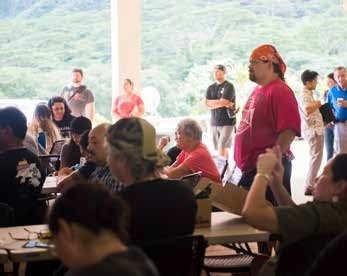 The ICS itself was seen as a tool for empowerment through education and information-sharing. Community leaders emphasized the importance of not just educating themselves about connectivity, but learning and sharing with other Indigenous communities, too. Maka’awa’awa said, “I’m here to learn and to empower ourselves, and then empower our community, and then at next year’s conference we’ll help to empower more Indigenous people.”
The ICS itself was seen as a tool for empowerment through education and information-sharing. Community leaders emphasized the importance of not just educating themselves about connectivity, but learning and sharing with other Indigenous communities, too. Maka’awa’awa said, “I’m here to learn and to empower ourselves, and then empower our community, and then at next year’s conference we’ll help to empower more Indigenous people.”
The Internet and culture
Many presentations underscored the Internet’s impact on culture, particularly through culture and language preservation. The Internet, and Internet-enabled technologies, allow communities to pass on stories in a way that was never possible before. “My future grandchildren will know me in a way that I never knew my grandfather,” said Ilihia Gionson, Outreach Liaison for Congresswoman Tulsi Gabbard.
Communities are leveraging the Internet to revitalize parts of their culture that may be otherwise endangered. Christopher Liu, a Master’s student at Stanford University, presented yugtun.com, a translation app he built to amplify his native language of Yup’ik. Christopher emphasized that a reliable broadband connection is essential to the app’s success; he explained that if a page takes longer than twenty seconds to load, people will close the site.
Ekela Kaniaupio-Crozier of Kamehameha Schools gave a presentation about how adding the Hawai’ian language to Duolingo, the language-learning app, has made it more accessible to students and their families. About 30 years ago, Hawai’ian was at risk of disappearing, but the Internet has provided a new opportunity to share the language.
The Internet also presents an opportunity for Indigenous youth to connect with others and share their stories. Linnea Dick and Joshua Watts of WeMatter shared their work using multimedia storytelling to help Indigenous youth build self-identity and feel less isolated. Many ICS participants also discussed the importance of students being able to remain in their communities and access educational materials online, as opposed to having to move away from their homes to further their studies.
While participants widely agreed that the Internet provides myriad opportunities for the preservation and sharing of culture, the group also discussed fears of how connectivity could negatively impact communities. Some shared discomfort with the parallels between the introduction of the Internet and a shared history of colonization. Others talked about potential threats online, such as scams, and fears that being connected could result in community culture being diluted. Ultimately, participants expressed that connectivity was most beneficial when the community was in the driver’s seat.
Storytelling as a mechanism for advocacy
Indigenous Peoples are often not given a seat at the table for policy making conversations, and it is widely understood that there is a lack of data that can accurately illustrate the experience of connectivity in Indigenous communities. Participants agreed on the importance of elevating the stories of Indigenous communities, and acknowledged that storytelling can be a powerful tool when advocating for policy change.
Storytelling was also seen as a strategy for elevating connectivity issues within Indigenous communities, and making those issues seem more approachable and within community control. Participants also advocated that storytelling can inspire others to take action – if individuals can see that people similar to them are speaking up, they may be more likely to do so.
Strong partnerships
Conversations throughout the ICS highlighted the role of partnerships in connecting Indigenous communities. While partnerships with a wide variety of stakeholders are beneficial, there were several key partner relationships at the forefront of Summit discussions.
In order to achieve the best outcomes, federal governments need to be collaborative partners with Indigenous communities. Participants emphasized the significant gaps between the consultation with Indigenous communities that some federal programs require, and effective and meaningful engagement.
Anchor institutions are often key players in community connectivity solutions. Patuk Glenn of the Arctic Slope Regional Corporation and Crystal Fraser of the Gwichya Gwich’in led a session on the role of schools in providing digital literacy training, cybersecurity workshops, and integrating technology into local culture.
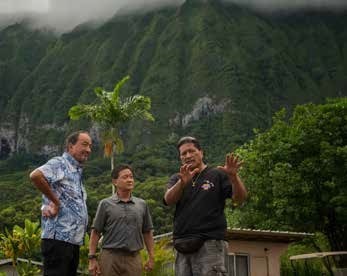
Indigenous leaders also stressed that partnerships with other communities help them to feel less alone. “When you’re working in an Indigenous community, sometimes you can start to become really isolated,” said Ula Shirt, Piikani Nation. She explained that talking to other community members led to new ideas, such as: “Is a policy that’s applicable to a reserve up north…applicable to us? How do we share that information and help each other develop policies?”
Sharing stories of success
The ICS provided a stage for local leaders to share stories of their networks. Communities shared their stories from across North America, from the Nez Perce Tribe in Idaho, to the Nation of Hawai’i, to the Eskasoni First Nation in Nova Scotia, and beyond. Non-Indigenous experts also discussed their experiences with community networks and other deployments.
This critical information sharing helps others to understand what’s possible, and builds a body of best practices. Not only does a candid discussion of missteps shine a light on lessons learned, but stories of success can inspire new projects and partnerships and provide a beacon of hope.
Internet infrastructure and community networks
During the ICS, an overview of the function and benefits of Internet Exchange Points (IXPs) was discussed in a technical session attended by about 30 participants. IXPs provide key function in improving Internet connectivity by allowing communities to keep more local traffic inside the community, hence saving on expensive transit costs. It also provides the opportunity for content providers to connect directly to the IXP and hence being closer to communities and improving user experience and network performance. Interest was high during the session from various communities present, including Nation of Hawai’i and West James Bay in Canada.
The Internet is a global network. All interconnected systems require backhaul to operate. Backhaul is the first-mile or middle-mile infrastructure that brings the Internet to the community; users can then use last-mile technologies to deliver services like the Internet for web browsing, cell phone, and television over the connection to their homes, businesses, and other institutions.
The key solutions for traffic backhaul in community networks in North America have been evaluated and documented in recent fact sheets by the Internet Society. The two fact sheets: “Solutions for Traffic Backhaul in Community Networks”, were released and distributed at the ICS. They cover wireline solutions, particularly fiber optic, as well as wireless solutions, including, microwave, WiFi, satellite and much anticipated Low Earth Orbit (LEO) satellites.[5]
Indigenous Connectivity Summit 2019 Artwork
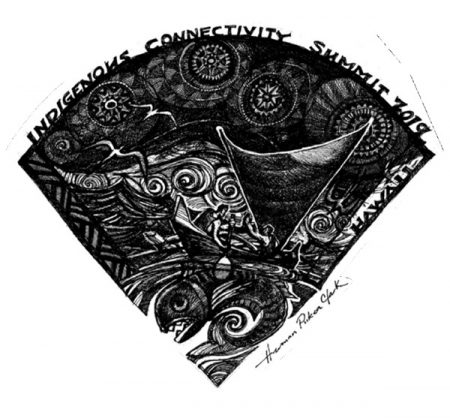
Artwork statement
Indigenous Connectivity Summit 2019
The concept of ‘connection’ is a principle central to Hawaiian and Pacific cultural beliefs. Indigenous knowledge systems from around the world are often based on a common central tenant: that all life on earth is connected – even inter- related. In Hawaii, the two thousand lines of the Kumulipo – a 17th century genealogical chant – affirms the Hawaiian cultural perspective that all known life forms in our islands – from the smallest coral polyp to fish, birds, plants, animals and human beings – are linked by a complex genealogical framework of kinship.
The image of the ho’okele wa’a – the ocean sailing navigator – composed especially for the Hawaii Indigenous Connectivity Summit, is a metaphor of the principle of ‘connection’ expressed in the lines of the kumulipo. All the natural elements – the sea birds and fish, the stars aligned, the ocean waves and the winds – function as a connected system of knowledge. Through the ancient Polynesian technology of the wa’a – read and guided by the skill of the navigator, the course and direction for our people – from the past through the present and into the future – is set.
– Herman Pi’ikea Clark
About the artist: Herman Pi’ikea Clark
 Born and raised in Honolulu, Herman Pi’ikea Clark is a keiki o ka ‘aina from a family with deep ancestral roots across Hawaii. A graduate of Punahou School, Herman completed a Master of Fine Arts in Pacific Design from the University of Hawaii and a Doctorate of Indigenous Education and Art from Massey University in New Zealand. Over the last twenty five years, he has gained international recognition as an artist, designer and professor of indigenous art and education. His artworks and design commissions can be found in both in private and public collections in Hawaii, the US mainland and the Pacific region.
Born and raised in Honolulu, Herman Pi’ikea Clark is a keiki o ka ‘aina from a family with deep ancestral roots across Hawaii. A graduate of Punahou School, Herman completed a Master of Fine Arts in Pacific Design from the University of Hawaii and a Doctorate of Indigenous Education and Art from Massey University in New Zealand. Over the last twenty five years, he has gained international recognition as an artist, designer and professor of indigenous art and education. His artworks and design commissions can be found in both in private and public collections in Hawaii, the US mainland and the Pacific region.
Policy Recommendations
The 2019 ICS brought together leaders and experts to explore challenges to and potential solutions for Indigenous connectivity. The rich discussions throughout the Summit led to the creation of eight policy recommendations.
The following were adopted as the 2019 ICS Policy Recommendations, in no particular order of importance, as all are considered equal priority:
- Native Hawaiians must be included as a Tribal Nation under the Federal Communications Commission’s definition.
- Indigenous (Tribal, Native Hawaiian, First Nations, Alaska Native, Metís, and Inuit) governments and/ or representative organizations must be engaged during the early planning stages of any project or policy that may affect their communities or land. By working with Indigenous communities early on, non-Indigenous entities may be able to form mutually beneficial and lasting relationships. Furthermore, Indigenous governments will be empowered to play an active role in the projects and policies that impact their communities.
- All Indigenous communities are unique, so engagement must be made on a community-by-community basis. The guidelines used by the Government of Canada6 may be a good starting point. Critically, this engagement should not be considered “tick the box” collaboration, but rather an opportunity to help Indigenous and non-Indigenous entities work together and form meaningful partnerships. Engagement guidelines should include information for non-Indigenous entities about who to contact within their community, the appropriate way to contact them, and some tips for smooth communication.
- The Federal Communications Commission (FCC) should push back the Tribal Priority window for the 2.5Ghtz Educational Broadband Service (EBS) Spectrum in the United States. Participants strongly agreed that the window should not begin until spring 2020 at the earliest and extend it from a 90-day window to a 180-day window at minimum. The FCC must also increase its efforts to promote this opportunity in order to reach all Tribal entities and educate them about the potential impact.
- Policymakers should work with appropriate representatives to improve and enforce accountability standards for companies or non-Indigenous entities working with Indigenous governments or other representative bodies. For example, funds provided by governments to connect Indigenous communities must be used in a demonstrably effective and efficient manner. In short, value for money spent.
- Organizations and agencies that use data on or intellectual property of Indigenous Peoples for their own purposes without consulting the owners of the knowledge should be held accountable. Metrics to determine the parameters of use for this data should be developed in consultation with appropriate representatives. The First Nations Principles of OCAP7 may serve as a guide.
- Policymakers should ensure that when new federal development funds for broadband are created, the criteria for applicants do not exclude Indigenous governments or community members. They should also open funding to all kinds of providers, including small or community-run networks.
- Federal regulators should ensure that Indigenous governments and Indigenous-owned entities have first rights to the spectrum over their lands. Unused spectrum over Indigenous lands should be reallocated for Indigenous use.
Process to Develop Policy Recommendations
A group of 2019 ICS Policy Advisors (Advisors) was tasked with creating this year’s policy recommendations. This group included Darrah Blackwater (Navajo Nation), Brandon Maka’awa’awa (Nation of Hawai’i), Ula Shirt (Piikani First Nation), and Darrian Danner (Alaska Native). The Advisors all attended the 2019 ICS and participated in the Internet Society’s Policy and Advocacy Training, an online series of sessions that took place in the months prior to the ICS, designed with stakeholder input in order to provide a deeper understanding of broad topics related to connecting Indigenous communities.
The Advisors were tasked with spearheading the development of policy recommendations based on the discussions at the Summit. The Advisors met prior to the ICS to discuss goals and potential foundations for those recommendations. They attended various breakout sessions and developed a preliminary list of recommendations based on participant discussions. The recommendations were then presented to the full group of ICS participants for further discussion and approval.
They participated in the ICS sessions and combined those learnings with their prior ICS training, personal backgrounds, and experiences to draft the ICS Policy Recommendations. The draft recommendations were shared at a dedicated roundtable session and presentation at the end of the day two at the Summit. ICS participants approved them through general consensus.
The ICS Policy Advisors will work with the Internet Society and the wider community of experts to promote the recommendations throughout the year.
Development of Indicators to Measure the Impact of the Internet on Indigenous Communities While it is understood that Internet access can bring benefits to communities, there is little evidence to demonstrate this. To this end, the Internet Society’s North American Regional Bureau is working with Dr. Heather Hudson – Professor Emerita at the University of San Francisco and Affiliate Professor and former Director at the Institute of Social and Economic Research at the University of Alaska, Anchorage – to propose criteria, indicators and methodologies that can be used to conduct research on the impact of the Internet in Indigenous communities in Canada and the United States.
At the 2019 ICS, the Internet Society held an invitation-only workshop with a select group of participants, facilitated by Dr. Hudson, to begin this work.
The results could be used to carry out field research on the impacts of community networks, and to share the findings with the communities, Indigenous leaders, and agencies engaged in policy-making, regulation, technologies, applications, and/or funding of community networks. We propose that this work be used to conduct baseline studies in Ulukhaktok, Northwest Territories, and Pu‘uhonua o Waimānalo, Hawai’i – communities that the Internet Society is working with to deploy networks in 2020.
A report from the workshop, including criteria, indicators and methodologies for further research, will be released in 2020. The hope is that with evidence that Internet access can make a positive difference in the social, cultural and economic wellbeing of communities, strong and effective arguments can be formed for enhanced funding for community networks.
All photos in this report are © Elise Butler.
Endnotes
[1] For more information about what this network means to the residents of Pu‘uhonua o Waimānalo, see: https://www.internetsociety.org/blog/2019/10/these-are-our-first-roadways-internet-access-and-self-determination-in-puuhonua-o-waimanalo/
[2] https://docs.fcc.gov/public/attachments/FCC-19-44A1.pdf
[3] http://www.naedb-cndea.com/wp-content/uploads/2019/06/NIEDB-2019-Indigenous-Economic-Progress-Report.pdf
[4] https://aipi.asu.edu/sites/default/files/tribal_tech_assessment_compressed.pdf
[5]https://www.internetsociety.org/resources/doc/2019/solutions-for-traffic-backhaul-in-community-networks/
